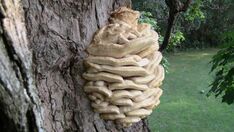Biology:Climacodon septentrionalis
| Climacodon septentrionalis | |
|---|---|

| |
| Scientific classification | |
| Kingdom: | |
| Division: | |
| Class: | |
| Order: | |
| Family: | |
| Genus: | |
| Species: | C. septentrionalis
|
| Binomial name | |
| Climacodon septentrionalis (Fr.) P.Karst. (1881)
| |
| Synonyms[1] | |
| |
Climacodon septentrionalis, commonly known as the northern tooth fungus or the white rot fungus, is a species of shelf fungus in the phylum Basidiomycota.[2] It is white in color and can be found in large clusters on the trunks of trees.[3] This species is a plant pathogen native to North America.[2]
Taxonomy
C. septentrionalis was originally described by Elias Magnus Fries in 1821 under the genus Hydnum.[4][5] It was later transferred to Climacodon in 1881 by Petter Karsten.[6]
Description

Individual caps are semicircular or kidney-shaped and can reach up to 30 cm across and 2.5-5.0 cm at the base.[2][3] They typically occur in large groups that can reach 80 cm in height.[2][3] Young caps range from mostly white to a yellow-cream color, and slowly become a yellow-brown as they age.[2][3] Although, the caps tend to persist for multiple weeks, allowing algae to grow, giving them a slightly green appearance.[3] The surface of the cap can be rough or even hairy, and can have concentric rings radiating out from the base.[3] The underside of the cap has many white spines (see left) that reach 1 cm in length and also yellow with age.[2] C. septentrionalis is edible but not palatable due to its tough flesh and bitter taste.[2][3] They can be found in the summer months and are a common cause of heart rot in hardwood trees in their native range.[2][3]
Habitat and Distribution
This species is native to northeastern North America, ranging from southern Canada to Kentucky, and as far west as the Great Plains.[2][3][7] C. septentrionalis is found on the trunks of living and recently deceased trees, especially beech (Fagus) and maple (Acer) species.[2][3]
Nematode Predation
C. septentrionalis was the first observed species fungus not in the genus Agaricus to secrete a toxin that it uses to immobilize and kill fungiphagous nematodes.[8][9] The mycelium of this species grows secretory cells the protrude outwards and develop branches that produce the substance in small droplets.[8] When a nematode comes in contact with a droplet, they become encased in it, and their motion is completely inhibited.[8] Death after contact occurs within several hours, but the rate at which a nematode was decomposed varied greatly, ranging from a few weeks to several days.[8]
Novel Compounds
C. septentrionalis has been found to produce a few different compounds that have potential to be used for a variety of products.[10] Esters are natural or synthetic, fragrant compounds that can be found in perfumes and flavorings, or used in paints, solvents, insecticides, and more.[11] The mycelium of this species produces esters that could be used in perfumes.[10][11] The compound furaneol is a commonly used in the cooking industry as a flavoring, with different forms having tastes ranging from a strawberry or pineapple to a caramel or honey flavor.[12] The furaneol found in C. septentrionalis is extracted from its fruiting bodies, and has a strawberry-like flavor and taste.[10]
References
- ↑ Index Fungorum
- ↑ 2.00 2.01 2.02 2.03 2.04 2.05 2.06 2.07 2.08 2.09 "Climacodon septentrionalis". https://www.messiah.edu/Oakes/fungi_on_wood/teeth%20and%20spine/species%20pages/Climacodon%20septentrionalis.htm.
- ↑ 3.00 3.01 3.02 3.03 3.04 3.05 3.06 3.07 3.08 3.09 "Climacodon septentrionalis (MushroomExpert.Com)". http://www.mushroomexpert.com/climacodon_septentrionalis.html.
- ↑ "Hydnum septentrionale Fr." (in en). https://www.gbif.org/species/164688318.
- ↑ "Index Fungorum - Names Record". http://www.indexfungorum.org/names/NamesRecord.asp?RecordID=214200.
- ↑ "Loading...". https://www.mycobank.org/page/Name%20details%20page/name/Climacodon%20septentrionalis.
- ↑ "Climacodon septentrionalis (Fr.) P.Karst." (in en). https://www.gbif.org/species/2541815.
- ↑ 8.0 8.1 8.2 8.3 Tanney, Joey B.; Hutchison, Leonard J. (2012-01-01). "The production of nematode-immobilizing secretory cells by Climacodon septentrionalis" (in en). Mycoscience 53 (1): 31–35. doi:10.1007/s10267-011-0128-1. ISSN 1340-3540. https://www.sciencedirect.com/science/article/pii/S1340354012700050.
- ↑ Soares, Filippe Elias de Freitas; Sufiate, Bruna Leite; de Queiroz, José Humberto (2018-02-01). "Nematophagous fungi: Far beyond the endoparasite, predator and ovicidal groups" (in en). Agriculture and Natural Resources 52 (1): 1–8. doi:10.1016/j.anres.2018.05.010. ISSN 2452-316X. https://www.sciencedirect.com/science/article/pii/S2452316X17302223.
- ↑ 10.0 10.1 10.2 Wu, Jing; Tsujimori, Megumi; Hirai, Hirofumi; Kawagishi, Hirokazu (2011). "Novel compounds from the mycelia and fruiting bodies of Climacodon septentrionalis". Bioscience, Biotechnology, and Biochemistry 75 (4): 783–785. doi:10.1271/bbb.100849. ISSN 1347-6947. PMID 21512224. https://pubmed.ncbi.nlm.nih.gov/21512224/.
- ↑ 11.0 11.1 "ester | Description, Types, & Reactions | Britannica" (in en). https://www.britannica.com/science/ester-chemical-compound.
- ↑ PubChem. "Furaneol" (in en). https://pubchem.ncbi.nlm.nih.gov/compound/19309.
Wikidata ☰ Q5133380 entry
 |

